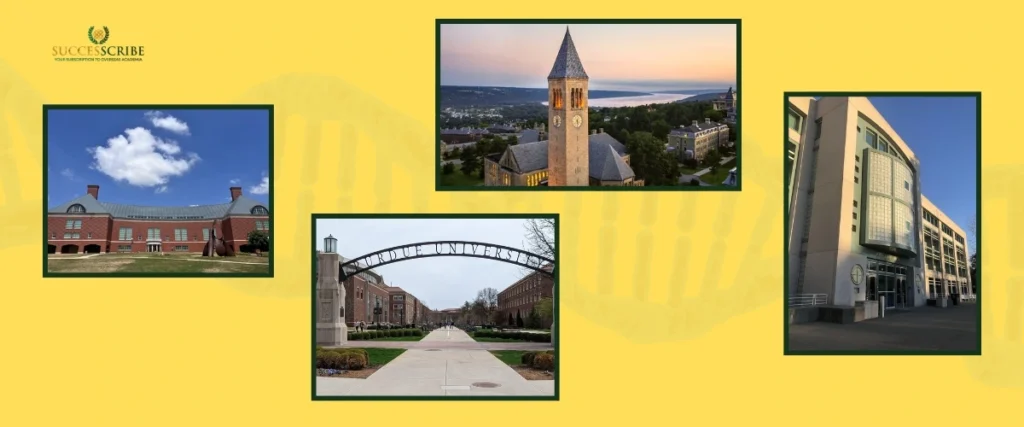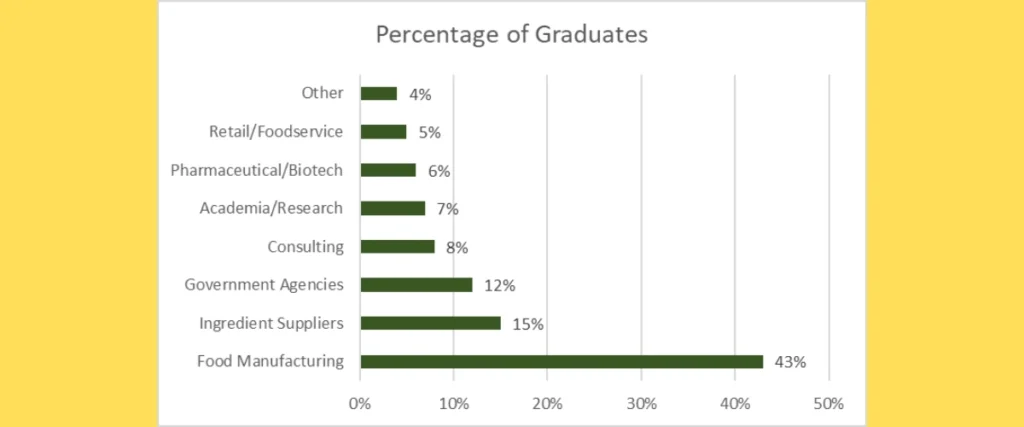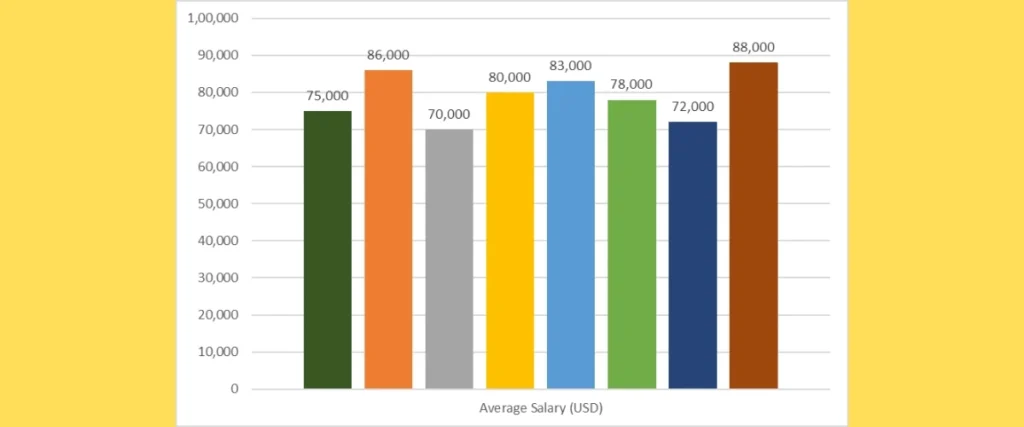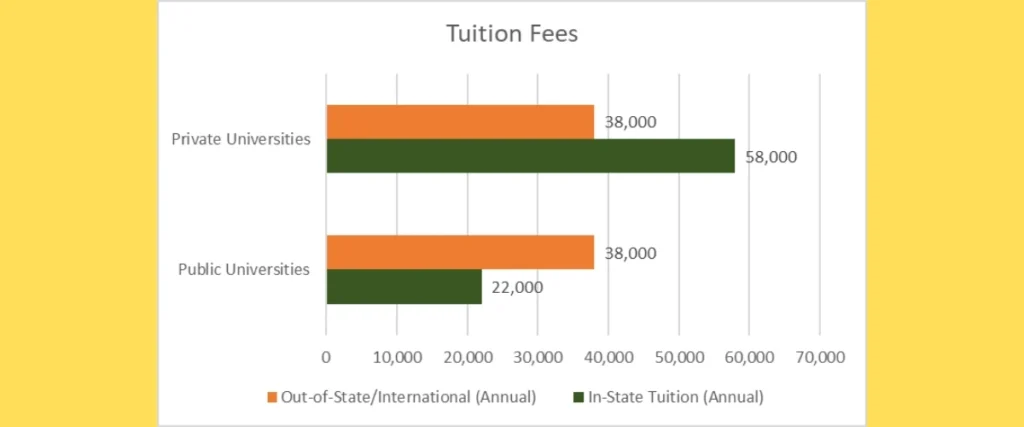Food science and technology represents one of the most dynamic and essential fields in modern scientific education. As global food systems become increasingly complex and consumers demand higher standards of safety, nutrition, and sustainability, the need for advanced food science professionals continues to grow. Masters in Food Science and Technology in USA have evolved to meet these challenges, offering world-class education that combines fundamental scientific principles with cutting-edge research and practical industry applications.
Why Pursue a Masters in Food Science and Technology in USA in 2025?
A Masters degree in Food Science and Technology offers numerous advantages in today’s competitive job market and evolving food landscape:
- 6 of the top 10 global Food Science programs are in the USA (QS Rankings 2025). Institutions like Cornell University, University of California-Davis, and University of Illinois Urbana-Champaign consistently rank among the top globally
- The Bureau of Labor Statistics (2025) forecasts 9% job growth (2025-2030) for food scientists.
- 72% of senior-level positions in food product development require or strongly prefer candidates with graduate degrees
- 83% of food companies report that advanced degrees significantly influence hiring and promotion decisions
- Students have opportunities to intern and collaborate with companies like Nestle, PepsiCo, Kellogg’s, and General Mills.
- Many universities receive federal and private funding, allowing students to engage in impactful research.
- According to the U.S. Bureau of Labor Statistics (BLS), employment for food scientists is projected to grow by 8% from 2022 to 2032, faster than the average for all occupations.
You May Also Like: Masters in data science in USA
Masters in Food Science and Technology in USA: Program Structure and Specializations
Masters programs in Food Science and Technology typically require 30-36 credit hours completed over 1.5-2 years. Programs generally fall into two categories:
- Thesis-based Masters: Research-intensive programs emphasizing original investigation and culminating in a formal thesis defense
- Non-thesis Masters: Coursework-focused programs often including capstone projects, industry practicums, or comprehensive examinations
Core Curriculum Components
Most programs include these fundamental areas:
- Advanced Food Chemistry (4-6 credits)
- Food Microbiology and Safety (3-4 credits)
- Food Processing Technologies (3-4 credits)
- Food Analysis and Instrumentation (3-4 credits)
- Research Methods and Experimental Design (2-3 credits)
- Sensory Evaluation (2-3 credits)
- Food Laws and Regulations (2-3 credits)
- Statistical Analysis in Food Science (2-3 credits)
Popular Specialization Tracks
Universities increasingly offer specialized concentrations reflecting industry needs and faculty expertise:
| Specailization | Focus Areas | Growth Trend (2019-2024) |
| Food Safety & Microbiology | Pathogen detection, HACCP, risk assessment | +31% |
| Food Chemistry & Analysis | Bioactive compounds, analytical techniques | +18% |
| Product Development | Consumer insights, formulation science | +27% |
| Sensory Science | Psychophysics, consumer testing methodologies | +22% |
| Food Processing & Engineering | Novel processing technologies, automation | +15% |
| Dairy Science | Dairy microbiology, dairy product technology | +7% |
| Cereal Science | Grain chemistry, baking technology | +11% |
| Food Biotechnology | Fermentation, bioprocessing, enzymology | +41% |
| Sustainable Food Systems | Life cycle assessment, alternative proteins | +53% |
| Nutrition & Functional Foods | Nutraceuticals, bioavailability, clinical trials | +38% |
You May Also Like: Engineering management courses in USA
Top Universities for Masters in Food Science and Technology in USA

The USA is home to some of the best universities for Food Science and Technology, offering cutting-edge research, industry collaborations, and strong career prospects. Below is a detailed list of the top-ranked institutions for a Master’s in this field:
| University | QS Rank |
| Cornell University | #20 |
| UC Davis | #38 |
| Purdue University | #99 |
| UIUC | #64 |
| Penn State | #93 |
| UW-Madison | #83 |
| Texas A&M | #134 |
| Ohio State | #151 |
| University of Florida | #168 |
| Michigan State | #159 |
1. Cornell University
| Category | Details |
| QS World Ranking | #20 |
| Program Offered | MS/PhD in Food Science |
| Duration | 2 years (MS) |
| Specializations | Food Chemistry, Microbiology, Sensory Science, Food Engineering |
| IELTS/TOEFL | IELTS (7.0)/ TOEFL (100) |
| GRE Requirement | Not required for MS (optional for PhD) |
| Tuition Fees (Annual) | 30,000–40,000 |
2. University of California-Davis (UC Davis)
| Category | Details |
| QS World Ranking | #38 |
| Program Offered | MS in Food Science |
| Duration | 2 years |
| Specializations | Fermentation, Food Safety, Sustainable Food Systems |
| IELTS/TOEFL | IELTS (7.0)/TOEFL (80) |
| GRE Requirement | Not required |
| Tuition Fees (Annual) | 35,000–45,000 |
3. Purdue University
| Category | Details |
| QS World Ranking | #99 |
| Program Offered | MS in Food Science |
| Duration | 1.5–2 years |
| Specializations | Food Processing, Carbohydrate Research, Food Chemistry |
| IELTS/TOEFL | IELTS (6.5)/TOEFL (80) |
| GRE Requirement | Required (waiver possible) |
| Tuition Fees (Annual) | 25,000–35,000 |
4. University of Illinois Urbana-Champaign (UIUC)
| Category | Details |
| QS World Ranking | #64 |
| Program Offered | MS in Food Science & Human Nutrition |
| Duration | 2 years |
| Specializations | Food Engineering, Nutrition, Biotechnology |
| IELTS/TOEFL | IELTS (6.5)/TOEFL (90) |
| GRE Requirement | Optional (recommended for funding) |
| Tuition Fees (Annual) | 30,000–40,000 |
5. Penn State University
| Category | Details |
| QS World Ranking | #93 |
| Program Offered | MS in Food Science |
| Duration | 2 years |
| Specializations | Dairy Science, Food Packaging, Food Safety |
| IELTS/TOEFL | IELTS (6.5)/TOEFL (80) |
| GRE Requirement | Not required |
| Tuition Fees (Annual) | 35,000–45,000 |
6. University of Wisconsin-Madison
| Category | Details |
| QS World Ranking | #93 |
| Program Offered | MS in Food Science |
| Duration | 2 years |
| Specializations | Dairy Science, Food Packaging, Food Safety |
| IELTS/TOEFL | IELTS (6.5)/TOEFL (80) |
| GRE Requirement | Not required |
| Tuition Fees (Annual) | 35,000–45,000 |
7. Ohio State University
| Category | Details |
| QS World Ranking | #151 |
| Program Offered | MS in Food Science & Technology |
| Duration | 2 years |
| Specializations | Functional Foods, Sensory Science, Food Processing |
| IELTS/TOEFL | IELTS (6.5)/TOEFL (79) |
| GRE Requirement | Required |
| Tuition Fees (Annual) | 30,000–40,000 |
8. University of Florida
| Category | Details |
| QS World Ranking | #168 |
| Program Offered | MS in Food Science |
| Duration | 2 years |
| Specializations | Citrus Research, Tropical Fruit Processing |
| IELTS/TOEFL | IELTS (6.0)/TOEFL (80) |
| GRE Requirement | Waiver possible |
| Tuition Fees (Annual) | 20,000–30,000 |
9. Texas A&M University
| Category | Details |
| QS World Ranking | #134 |
| Program Offered | MS in Food Science & Technology |
| Duration | 2 years |
| Specializations | Meat Science, Food Microbiology, Engineering |
| IELTS/TOEFL | IELTS (6.0)/TOEFL (80) |
| GRE Requirement | Required |
| Tuition Fees (Annual) | 20,000–30,000 |
10. Michigan State University
| Category | Details |
| QS World Ranking | #159 |
| Program Offered | MS in Food Science |
| Duration | 2 years |
| Specializations | Meat Science, Food Packaging, Biotechnology |
| IELTS/TOEFL | IELTS (6.5)/TOEFL (80) |
| GRE Requirement | Waiver possible |
| Tuition Fees (Annual) | 25,000–35,000 |
You May Also Like: Duolingo accepting universities in USA
Career Prospects and Industry Demand
Food science graduates enter a robust job market with diverse opportunities across numerous sectors.
Employment Statistics
Recent data from the Institute of Food Technologists (IFT) and the Bureau of Labor Statistics highlight strong employment prospects:
- 91% of Food Science Masters graduates secure relevant employment within 6 months of graduation
- Average starting salary: $72,500 (representing a 31% premium over Bachelor’s degree holders)
- Unemployment rate for food scientists: 1.7% (compared to national average of 3.8%)
- Projected job growth rate (2023-2033): 7% (faster than average)
- Time-to-promotion averaging 2.7 years (compared to 4.1 years for Bachelor’s graduates)
Industry Distribution of Recent Graduates

| Sector | Percentage of Graduates | Key Roles |
| Food Manufacturing | 43% | Product development, quality assurance, processing |
| Ingredient Suppliers | 15% | Application scientists, technical sales |
| Government Agencies | 12% | Regulators, inspectors, researchers |
| Consulting | 8% | Technical consultants, food safety auditors |
| Academia/Research | 7% | Researchers, laboratory managers |
| Pharmaceutical/Biotech | 6% | Formulation scientists, clinical trial specialists |
| Retail/Foodservice | 5% | Quality systems, product specification |
| Other | 4% | Entrepreneurship, nonprofit organizations |
Salary Expectation After Masters in Food Science and Technology in USA

According to BLS and PayScale data, here are some popular career roles and their respective average annual salaries in 2025:
| Job Title | Average Salary (USD) |
| Food Scientist | $75,000 |
| Quality Assurance Manager | $86,000 |
| Food Technologist | $70,000 |
| Sensory Scientist | $80,000 |
| Product Development Scientist | $83,000 |
| Regulatory Affairs Specialist | $78,000 |
| Nutrition Scientist | $72,000 |
| Research Scientist (Food) | $88,000 |
You May Also Like: Digital marketing courses in USA
Top Companies Hiring Food Science Graduates
Here are the top companies hiring Food Science Graduates in USA
| Company | Industry | Roles Offered |
| Nestle | Food & Beverage | R&D, QA, Product Dev |
| PepsiCo | Food & Beverage | Food Technologist, QA Analyst |
| Mondelez International | Snacks & Confectionery | Process Engineering, Product Dev |
| Unilever | FMCG | Sensory Science, Packaging R&D |
| Danone | Dairy & Nutrition | Quality Control, Food Safety |
| Cargill | Agribusiness | Food Innovation, Supply Chain Analyst |
| Kellogg’s | Breakfast Foods | Food Safety, Product Development |
Admission Requirements and Application Process
Admission to Masters programs in Food Science is competitive, with top programs accepting only 20-35% of applicants. Requirements typically include:
Academic Prerequisites
- Bachelor’s degree in food science or related field (chemistry, biology, engineering)
- Minimum GPA of 3.0-3.5 (requirements vary by program)
- Prerequisite coursework in:
- General chemistry (2 semesters)
- Organic chemistry (1-2 semesters)
- Biochemistry (1 semester)
- Microbiology (1 semester)
- Calculus or statistics (1 semester)
- Food science fundamentals (for non-food science undergraduates)
Standardized Testing
Testing requirements have evolved significantly in recent years:
- 63% of programs still require GRE scores (down from 91% in 2019)
- Average GRE scores for accepted students at top-10 programs:
- Verbal: 155-158
- Quantitative: 158-165
- Analytical Writing: 4.0-4.5
For international students:
- IELTS: Minimum 6.5-7.0 (program dependent)
- TOEFL: Minimum 90-100 iBT (program dependent)
Application Components
Most programs require:
- Online application form
- Statement of purpose/research interests
- 2-3 letters of recommendation
- Official transcripts
- Resume/CV
- Application fees ($60-120)
Some programs additionally require:
- Writing samples
- Faculty research interest matching statements
- Pre-admission interviews
Application Timeline for Masters in Food Science and Technology in USA
| Month | Milestones |
| August-September | Research programs, contact potential advisors |
| October-November | Take GRE/TOEFL if required, request recommendation letters |
| December-January | Submit applications (most deadlines fall in this period) |
| February-March | Interviews conducted, initial offers made |
| April 15 | Council of Graduate Schools universal decision date |
| May-June | Second round offers, waitlist movement |
| August-September | Programs begin |
Work Visa and Post-Study Work Opportunities
After completing a Master’s degree in the USA, international students are eligible for Optional Practical Training (OPT):
- Duration: 12 months, extendable to 36 months if on a STEM-designated program (Food Science is STEM-designated).
- During OPT, students can work full-time in their field of study.
- Many students transition to H-1B work visas sponsored by their employers.
You May Also Like: Aerospace engineering in USA
Tuition Fees for Masters in Food Science and Technology in USA

Graduate education in Food Science represents a significant investment, with costs varying substantially based on institution type and residency status.
| Institution Type | In-State Tuition (Annual) | Out-of-State/International (Annual) |
| Public Universities | $12,000 – $22,000 | $26,000 – $38,000 |
| Private Universities | $35,000 – $58,000 | $26,000 – $38,000 |
Living Expenses
Beyond tuition, students should budget for:
- Housing: $800 – $1,800 per month depending on location (university housing is often more affordable)
- Food: $300 – $500 per month
- Health Insurance: $1,500 – $2,500 per year (many universities require enrollment in their health insurance plans)
- Books and Supplies: $1,000 – $1,500 per year
- Transportation: $500 – $1,200 per year
- Personal Expenses: $1,000 – $2,000 per year
Scholarships and Financial Aid for International Students
Many universities and external organizations offer scholarships and assistantships for international students pursuing Masters in Food Science and Technology in USA:
- Fulbright Foreign Student Program
- AAUW International Fellowships (for women)
- University-based Scholarships: Like the Cornell Graduate School Fellowship or UC Davis Global Fellowship
- Teaching/Research Assistantships: Partial or full tuition waivers + monthly stipend ($1,200 – $2,200/month)
Conclusion
A Masters in Food Science and Technology in USA in 2025 opens doors to dynamic careers in a rapidly advancing field. With access to world-class education, high-paying jobs, and global recognition, the USA is a leading destination for aspiring food scientists. From improving public health through nutrition to innovating sustainable food technologies, graduates are at the forefront of shaping the future of food.
For students passionate about science, health, and innovation, this degree not only promises a fulfilling academic experience but also ensures robust career prospects in a critical industry that feeds the world.
FAQs
Can I pursue a Master’s in Food Science and Technology in the USA without a background in Food Science?
Yes, many programs accept students from related fields like Chemistry, Biology, Nutrition, or Biochemistry. However, you may need to complete prerequisite courses in food science fundamentals before beginning core coursework.
Is it possible to get a Master’s in Food Science and Technology in the USA without taking the GRE?
Yes, several universities like Purdue, University of Florida, and University of Georgia have waived GRE requirements or made them optional, especially for students with strong academic backgrounds.
Do universities in the USA offer paid internships or assistantships for Food Science students?
Yes, many universities provide research or teaching assistantships, which can include tuition waivers and stipends. Paid internships with food industry giants are also commonly available.
If my GPA is low (2.5-2.9), which US universities will still accept me for Food Science Masters?
1. Kansas State University (conditional admission with bridge courses)
2. University of Idaho (considers work experience over GPA)
3. Rutgers (allows provisional enrollment after interview)
What scholarships are available for MS in Food Science and Technology for Indian students?
Scholarships include Fulbright-Nehru Master’s Fellowship, Inlaks Shivdasani Foundation, and specific university-based scholarships like the Food Science Graduate Fellowship at the University of Minnesota or Purdue’s Diversity Fellowship.
How do Food Science graduates qualify for H-1B sponsorship jobs?
Roles like Food Technologist, Quality Assurance Specialist, Research Associate, and Regulatory Affairs Analyst are common H-1B eligible positions. Having a STEM degree and internship experience boosts your sponsorship chances.
You Must Also Like
Masters in interior design in USA
Masters in business analytics in USA
Masters in computer science in USA
Masters in cyber security in USA












